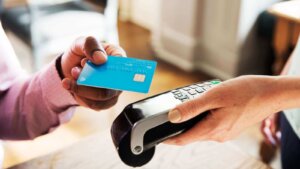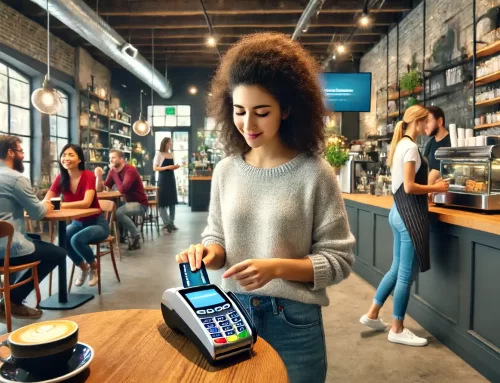Contactless credit card devices are becoming a staple in modern payment technology, utilized globally not just for their convenience but also for their robust security features. This article delves into how these devices work, their safety measures, and the financial institutions that offer them, ensuring you have all the information you need about contactless credit cards.
Here’s everything you didn’t know you needed to know about contactless credit cards.
What Is a Contactless Credit Card?
As long as your credit card is within range of the scanner, you may use the contactless credit card to make a transaction. Like a credit card, you transfer short-range electromagnetic waves from the card to the POS system, where they are collected and processed. Instead of implanted chips, contactless credit cards allow you to “insert” rather than “swipe.” Because of its technology, contactless cards seem like any other card. There should be a magnetic strip on the back of every credit card, as well as a place to write important information regarding credit cards.
The processing of conventional payment methods may take up to 10 times as long as the processing of contactless payments, sometimes referred to as “tap and go” or “tap to pay.” In addition to using contactless credit cards, users of contactless mobile devices such as smartphones and smartwatches can use the contactless payment option.
What are Contactless Credit Card Devices?
Contactless credit card devices utilize radio-frequency identification (RFID) technology or near-field communication (NFC) to conduct secure transactions without the need for physical contact. These devices allow a cardholder to complete a payment by simply waving or tapping their card near a compatible payment terminal. This method uses embedded chips that transmit payment information to the contactless-enabled terminal, streamlining the transaction process dramatically.
Unlike traditional credit cards that require swiping or inserting into a payment terminal, Contactless Credit Card Devices ensure that the card never has to leave the holder’s hand, reducing the risk for card theft or fraud. Each transaction is completed with a unique, one-time code that protects the user’s payment information, adding an extra layer of security. Given their efficiency and enhanced security measures, contactless cards are rapidly gaining popularity among consumers and retailers worldwide, marking a significant advancement in digital payment technology.”
Functioning of Contactless Credit Cards
Contactless credit cards have a tiny chip that emits electromagnetic waves. This chip, not the inserted chip, would be used instead of swiping. Your payment information is instantaneously transferred when you place your card near a contactless payment terminal.
However, despite the phrase “tap to pay,” tapping is not required. A few inches away from the machine is usually all required to make a credit card transaction.
Don’t hurry to get your card out of the way since the transaction may take a few seconds to complete. Depending on the payment terminal, a buzzer, a green checkmark, or flashing green light may indicate that the transaction has been completed.
How can you use Contactless Credit Card Devices?
For the contactless payment function to work, the store must have a terminal accepting payment without touching the card. These payment terminals are becoming increasingly widespread in the United States, as in Canada, Europe, and Australia. Use tools like the Mastercard Contactless Locator to find nearby merchants that accept Mastercard contactless cards. A terminal may often receive contactless cards if it has a little Wi-Fi symbol on them.
Hold your contactless card over the point-of-sale or card terminal to begin your transaction if the shops where you shop contactless support payments. Hold the card up to the machine for a second or two before attempting to use it. The terminal will display a message congratulating the user if everything goes well.
You’ll need several contactless credit cards in your wallet or handbag to use a card reader. To avoid this, make sure that the transaction is on your intended card. Always remove the card you want to use to pay from your wallet before making a transaction. To avoid going through your wallet for your card, use a digital wallet service like Apple Pay or Google Pay to connect your contactless credit card. Apple Pay or Google Pay should have your primary credit card listed as the default if you use more than one contactless credit card.
If you carry a slew of contactless credit cards, you’ll want to avoid touching the terminal with your wallet or purse. This might result in your purchase being charged to a card you didn’t intend. Make sure you have your credit card on hand when making a purchase.
Making a purchase using a contactless credit card may be as simple as putting your smartphone over the card reader instead of digging through your wallet for your card. Keep your primary contactless credit card as the default in Apple Pay or Google Pay if you have several cards.

CONTACTLESS CREDIT CARD DEVICES
Benefits of Contactless Credit Cards
-
Reduced Wear and Tear
Repeated magnetic strips and EMV chips at payment terminals might cause them to wear out. Due to the way they operate, contactless chips cannot have this issue. The longevity of a contactless card chip is expected to be relatively high.
- Suitable for Travel Abroad
While many of us cannot go outside of the country just yet, contactless cards will come in handy when we do. Chip and PIN technology has become the norm in Europe and Australia, where it is widely employed. Many self-service ticket machines require chip and PIN cards, or cards that may be paid for without touching them. If you don’t have a Chip and PIN card, you may only be able to pay using a contactless credit card at some merchants.
-
Speedy
Using a credit card chip by “dipping” or “inserting” it into a reader has become commonplace. When you input your card number and wait for a confirmation, most payment terminals buzz or ding to let you know when you may finally withdraw your card. This happens because we all start thinking about something else during this moment.
In contrast, using a contactless chip and “tapping” to pay takes seconds at most. Contactless payments are much quicker and more secure than inserting a credit card.
- Decreased Exposure to Public Surfaces
Public surfaces have been brought back into the spotlight with the emergence of Covid-19. With contactless credit cards, customers have fewer opportunities to get their hands on the card.
Are Contactless Cards Safe?
Using a contactless credit card is now one of the safest payment methods. Contactless credit cards create a one-of-a-kind code for each transaction that is almost impossible for hackers to replicate. Magnetic-stripe credit cards are simpler to clone than contactless credit cards. Credit card theft is the simplest method for a criminal to utilize contactless payments. Using contactless payments, criminals may be able to get away with conducting fraudulent transactions since they don’t need to sign their names. There is a good chance that any fraudulent transactions will be returned to your account since card issuers’ fraud teams have improved. The card issuer should be contacted immediately if your credit card is lost or stolen or if you suspect fraud. While fraud is becoming more challenging to detect, you should not rely on a fraud monitoring service or your bank to do it.
As of Covid-19, contactless payments are more convenient than swiping credit cards or entering a personal identification number (PIN). This is because card terminals are less likely to be handled, reducing the risk of spreading germs or viruses.
Have any questions regarding the topic “CONTACTLESS CREDIT CARD DEVICES” feel free to comment below.
Also Read: Contactless Payment Processing




